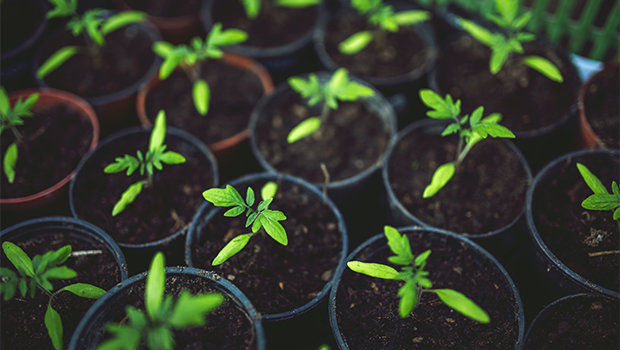
Fresh-picked everything just tastes better! Give container gardening a try and harvest delicious herbs and vegetables all summer long.
Gardening in containers is an easy way to grow herbs and vegetables if you’re new to gardening or have little gardening space. Even the smallest deck, porch or patio makes an ideal spot for growing in pots. Culinary herbs are especially fun to grow and require very little care, and container-grown greens and vegetables taste better than anything you’ll buy at the grocery store. With just a few basic container gardening supplies, you’ll be growing fresh and healthy edibles in no time at all and eating more mindfully just a few weeks after planting.
WHAT YOU’LL NEED
Pots and containers: Use 15 cm or larger containers for herbs and at least 30 cm pots for vegetables. Tomatoes and zucchini grow well in large tubs or wooden barrels. Choose from a wide array of affordable pots: terra cotta, ceramic, resin and more. Drainage holes in pots are essential so the excess water can drain.
Soil: Purchase a chemical-free planting mix that has some compost and a slow-release fertilizer mixed in. Avoid bagged topsoil and don’t use soil from your yard for containers.
Trowel: You’ll only use one tool—a trowel, so be sure to buy one that feels good in your hand. You’ll use the trowel to fill containers and dig holes for seedlings or for planting seeds.
Container trellis or support: If you’d like to grow a vining vegetable, like cucumbers, peas or pole beans, you’ll need a simple support of bamboo or metal. Most tomatoes, even the compact varieties, benefit from staking, tomato cages or towers.
Seedlings or seeds: Buy nursery-grown seedlings or seed packets and be sure there’s growing information available about the plant, either on a plant tag, seed packet or online. For nursery seedlings, be sure the plant has healthy leaves with no discoloration or fading, has a short, strong stem and isn’t spindly and shows no signs of infestation (check the undersides of the leaves for pests).
Sunlight: Choose a sunny spot for your containers, with at least 6 hours a day of direct sun. However, patio stones and concrete can really heat up a container and dry out a pot quickly so you may need to move a container into a partially shady spot (under a table or tree) if your seedlings are wilting in the afternoon sun.
Water: Containers need to be watered thoroughly daily with a watering can or hose (terra cotta containers dry out quickly and may need water twice a day). Be sure to keep the soil moist (not saturated, though) at all times.
Chemical-free fertilizer: Since you’re growing edibles, choose an organic fertilizer to add soil nutrients. Follow directions on the packaging to mix and apply fertilizers.
WHICH PLANTS TO CHOOSE
With countless choices for herbs and vegetables to grow in containers, simply start with the things you like to eat. An easy rule of thumb: it’s one plant variety to a pot. If you love caprese salad, try growing basil and tomatoes. Ratatouille on the menu? Then grow bell peppers and zucchini. If you serve salad at every meal, plant arugula and flat-leaf parsley. Are you a pickle lover? Grow cucumbers and dill and make your own refrigerator pickles.
Almost every culinary herb grows well in a container and can add flavour to salads and dressings, entrées and sides. Try growing basil, chives, dill, oregano, parsley, rosemary, sage and thyme. Choosing vegetables to grow in a container requires a little more knowledge because some vegetables may climb and sprawl or require deep, loose soil. If you’re just starting with container gardening, try any of these vegetables: beans (bush beans are preferred but pole beans will do great on a small trellis), collards, cucumbers, eggplant, kale, kohlrabi, lettuce and other salad greens, peas, peppers, radishes, spinach (smooth leaved, savoy and baby leaf varieties are best for spring or fall planting) and tomatoes.
WHAT YOU’LL DO
Once you’re past the last frost date, you can get started with container gardening. Research “days to maturity” for each plant variety to give you a general idea of when to begin harvesting.
Fill your container about 2/3 full with planting mix. If you’re filling a very large container, first move the container to its final spot, then add the planting mix.
For seedlings: Using a trowel, dig a hole about 1 1/2 times as wide as the seedling container and about the same depth as the container. Remove the seedling from the container by gently squeezing the sides to loosen the soil and root ball or turn the plant upside down, tap on the container bottom and gently pull on the plant’s stem. Place the root ball in the hole, fill around the root ball and pat the soil firmly. It’s best to plant seedlings on a cloudy day to lessen transplant shock.
For seeds: Read the seed packet to determine planting instructions, especially planting depth for seeds. Follow the instructions on the seed packet to place and cover the seed.
Water the seedling or seed thoroughly, until water runs from the drainage holes.
Handle seedlings and emerging seeds with care. Keep the soil moist but not drenched and keep the container free of weeds.
In just a matter of weeks, your herbs and vegetables may be ready to harvest!
ENJOY YOUR HARVEST
Growing your own fresh herbs and vegetables nourishes your soul and brings wholesome, fresh flavours to your home-cooked meals. Mindful uses fresh herbs and vegetables in many of its delicious recipes. Try homegrown spinach in this amazing grilled haloumi salad. There are plenty ways to use your harvest in delicious dishes.
 Mindful Sodexo
Mindful Sodexo 
0 Comments